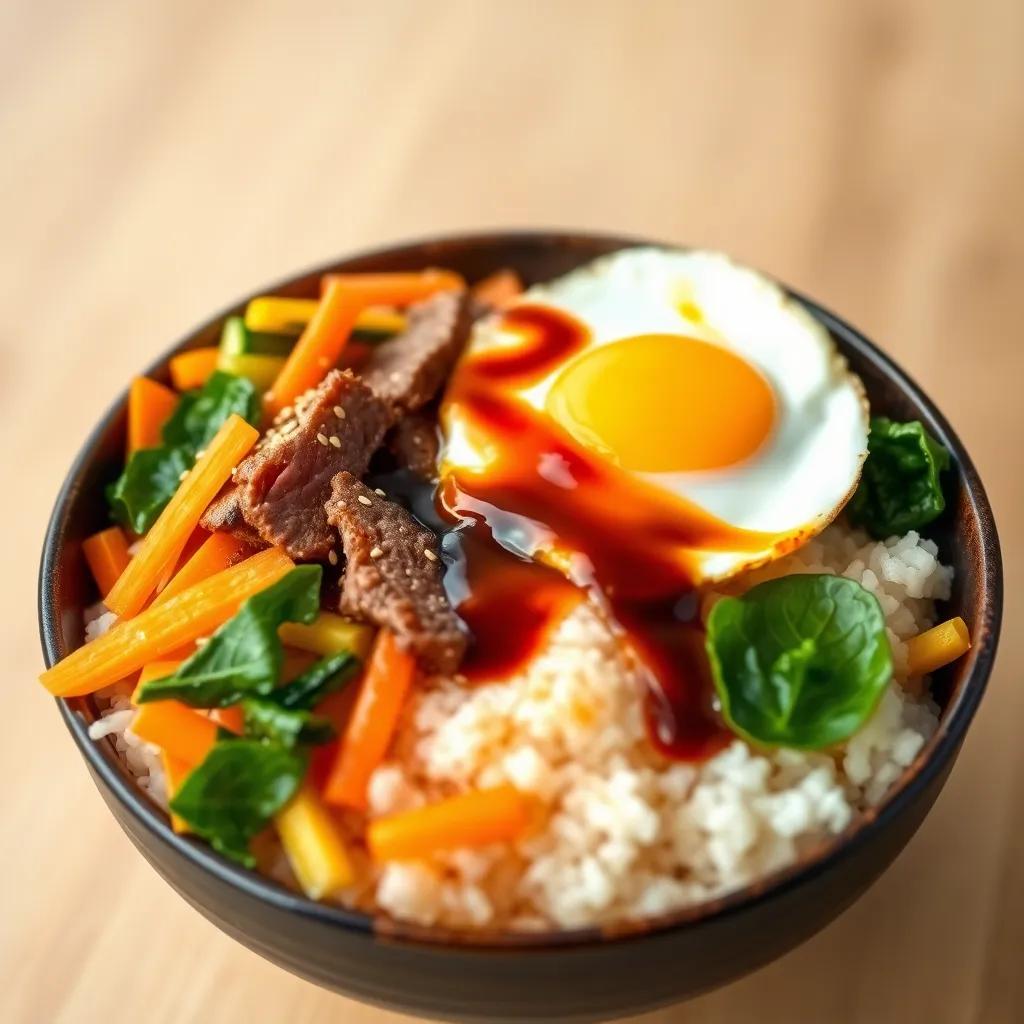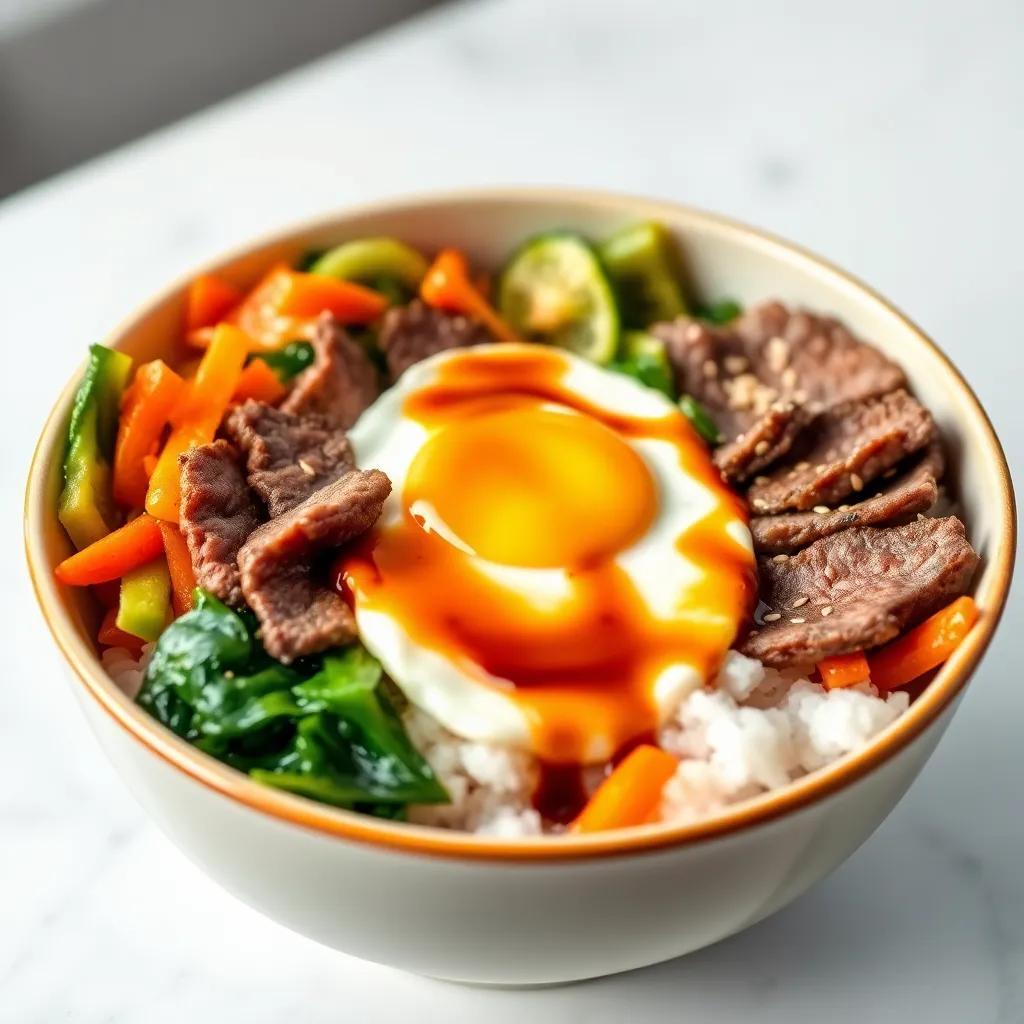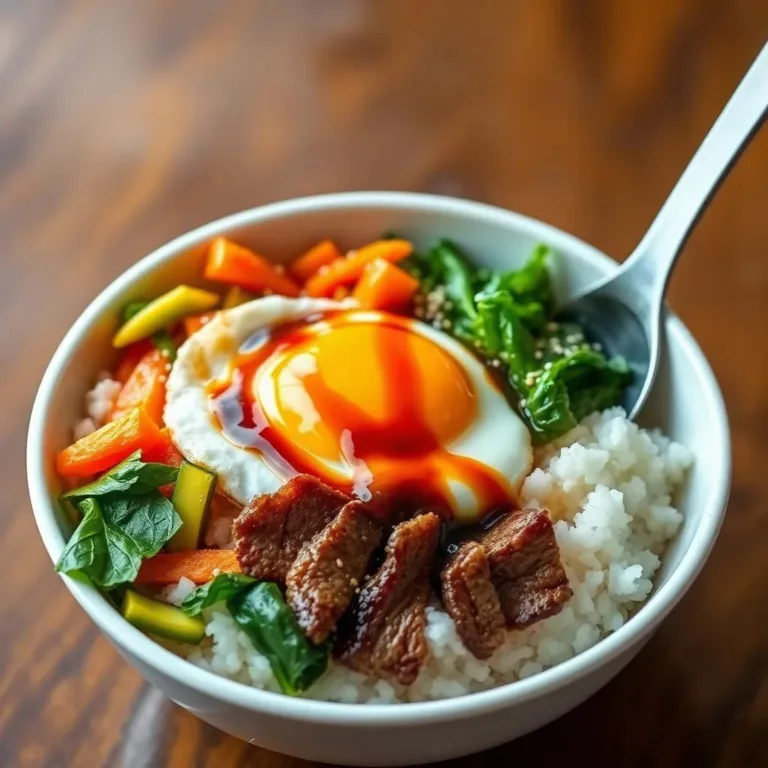Are you ready to dive into the world of Bibimbap? This delightful Korean dish is a colorful mix of rice, veggies, and savory goodness that will make your taste buds dance! Join me as I share my favorite tips and tricks to create your own perfect Bibimbap right at home—let’s get cooking!
What is Bibimbap? Understanding Korea’s Beloved Rice Bowl
Bibimbap is one of Korea’s most famous dishes, and for good reason! It’s like a party in a bowl, mixing all sorts of delicious flavors and vibrant colors. When I think of Bibimbap, I picture a warm rice bowl topped with seasoned vegetables, marinated beef, and a fried egg right on top—yum! But it’s the Bibimbap sauce that takes this dish to the next level!
This meal is all about variety. You can customize it with whatever you have on hand. Want to use chicken, tofu, or even seafood? Go for it! The beauty of Bibimbap is that there are no strict rules!
Here’s a quick breakdown of what makes up this fabulous dish:
- Rice: Usually short-grain white rice, it’s the base of your Bibimbap.
- Veggies: Think colorful sautéed zucchini, carrots, and fresh spinach.
- Protein: Traditionally marinated beef, but feel free to swap it out.
- Egg: A sunny side up egg adds richness and creaminess.
- Sauce: A spicy, savory sauce ties everything together.
Bibimbap isn’t just a meal; it’s an experience! You’ll find that mixing everything together is half the fun. I love the moment when the rice, veggies, and sauce become this delicious blend. It’s comfort food at its finest! Now, are you ready to make your own Bibimbap? Let’s go!

Essential Ingredients for an Authentic Bibimbap Experience
Creating a delicious Bibimbap starts with the right ingredients! This dish is all about variety and flavor, so let’s dive into what you need to make your Bibimbap truly authentic and mouthwatering!
Here’s a list of essential ingredients to gather:
- Short-grain white rice: This is the base of your dish. It’s sticky and easy to pick up with chopsticks!
- Marinated beef: Traditionally, thinly sliced beef is used. You can marinate it with soy sauce, garlic, and a touch of sugar for that sweet flavor.
- Vegetables: The more colorful, the better! Popular choices include:
– Carrots: Cut into thin batons for a nice crunch.
– Zucchini: Sautéed until tender, adding a lovely soft texture.
– Spinach: Quick to cook and adds a fresh touch.
– Shiitake mushrooms: Loaded with umami flavor, they’re a must!
– Bean sprouts: They add a lovely crunch, so don’t skip them!
- Fried egg: A runny yolk on top is the cherry on the cake, or should I say bowl!
- Bibimbap sauce: This spicy and savory concoction is what brings everything together!
Feel free to mix it up. If you have other vegetables or proteins you like, toss them in! My personal favorite is adding some kimchi for an extra kick. So, gather your ingredients, and let the fun begin! It’s going to be a flavor explosion!

How to Prepare the Perfect Bibimbap Sauce
Ah, the Bibimbap sauce! This spicy, savory delight is what makes the dish truly sing. I can’t get enough of it! Making your own sauce is super easy, and it’s a game-changer for your Bibimbap. Trust me, once you try it, you might want to slather it on everything!
Here’s what you’ll need for the sauce:
- 4 tablespoons Gochujang: This is the magic ingredient! It’s a Korean chili paste with a tangy kick.
- 2 tablespoons mirin: A sweet rice wine that adds a lovely depth of flavor.
- 2 tablespoons rice vinegar: This gives a nice zesty touch to the sauce.
- 1.5 teaspoons soy sauce: For a hint of umami goodness.
- 3 teaspoons white sugar: This balances out the spice and acidity.
- 1 garlic clove, finely grated: Because who doesn’t love garlic?
- 2.5 teaspoons toasted sesame oil: This adds a nutty aroma that’s simply irresistible!
Steps to make the sauce:
- In a small bowl, mix together the Gochujang, mirin, rice vinegar, and soy sauce.
- Add the sugar and mix until it’s dissolved.
- Stir in the garlic and sesame oil.
And voilà! You have a vibrant, delicious Bibimbap sauce ready to go! Feel free to adjust the ingredients to your taste—more spice? Add extra Gochujang! A touch sweeter? Toss in a bit more sugar! I love pouring a generous amount over my Bibimbap before mixing it all up. It’s the perfect finishing touch! Enjoy!
Step-by-Step Guide to Cooking Bibimbap Vegetables
Cooking the vegetables for your Bibimbap is like creating a colorful masterpiece! The best part is that each veggie brings its own flavor and texture to the table. Let’s talk about how to prepare these vibrant ingredients so they’re just right for your dish!
Here’s how I like to cook my Bibimbap vegetables:
- Shiitake Mushrooms:
– Start by soaking dried shiitake mushrooms in boiling water for about 30 minutes.
– Once they’re nice and soft, slice them and sauté in a pan with a little garlic, soy sauce, and sugar for about 2 minutes. Yum!
- Carrots and Zucchini:
– Cut both into thin batons—this helps them cook evenly.
– You can sprinkle them with salt and let them sit for 20 minutes to draw out moisture (but I often skip this step).
– Sauté until tender, around 5 to 8 minutes for the carrots and about 4 minutes for the zucchini.
- Spinach:
– Quick and easy! Just chop the spinach and sauté it in a splash of oil until it starts to wilt, maybe a minute or two.
- Bean Sprouts:
– You can steam or boil them until they’re just wilted, which usually takes about 5 minutes.
– After that, squeeze out any extra water and mix with soy sauce, garlic, and a touch of sesame oil for flavor.
Other Vegetable Options:
Feel free to experiment! You can swap in different veggies like asparagus, bell peppers, or broccoli. The sky’s the limit! Just remember to cook each type separately to keep the flavors distinct and enjoy this colorful cooking adventure!

Tips for Assembling and Enjoying Your Bibimbap
Now comes the fun part—assembling your Bibimbap! This is where you can let your creativity shine, and it’s almost like playing with your food (in a good way)! Here are my top tips for making it not only delicious but also super Instagram-worthy!
Step-by-Step Assembly:
- Start with the Rice:
– Scoop a generous serving of cooked white rice into a bowl. This is the fluffy foundation of your Bibimbap!
- Add the Vegetables:
– Neatly arrange each of your sautéed vegetables around the rice. Think of it like a colorful rainbow!
– I like to use alternating colors—who doesn’t love a beautiful presentation?
- Top with Protein:
– Place your marinated beef (or your choice of protein) right in the center. This not only looks inviting but also adds a punch of flavor!
- Don’t Forget the Egg:
– Gently lay a fried egg on top. I always go for a runny yolk; it makes everything creamy and delicious!
- Drizzle the Sauce:
– Here’s where the magic happens! Drizzle your prepared Bibimbap sauce over the top. Don’t be shy—add as much as you like for that spicy kick!
Time to Dig In!
Once everything is beautifully arranged, it’s time to mix it all up! Grab your chopsticks (or fork, no judgment here!), and combine all the flavors into one delightful mess. Each bite is a burst of texture and taste! I love the excitement of getting a bit of everything in each mouthful. Enjoy your homemade Bibimbap, and don’t forget—food is meant to be fun!

